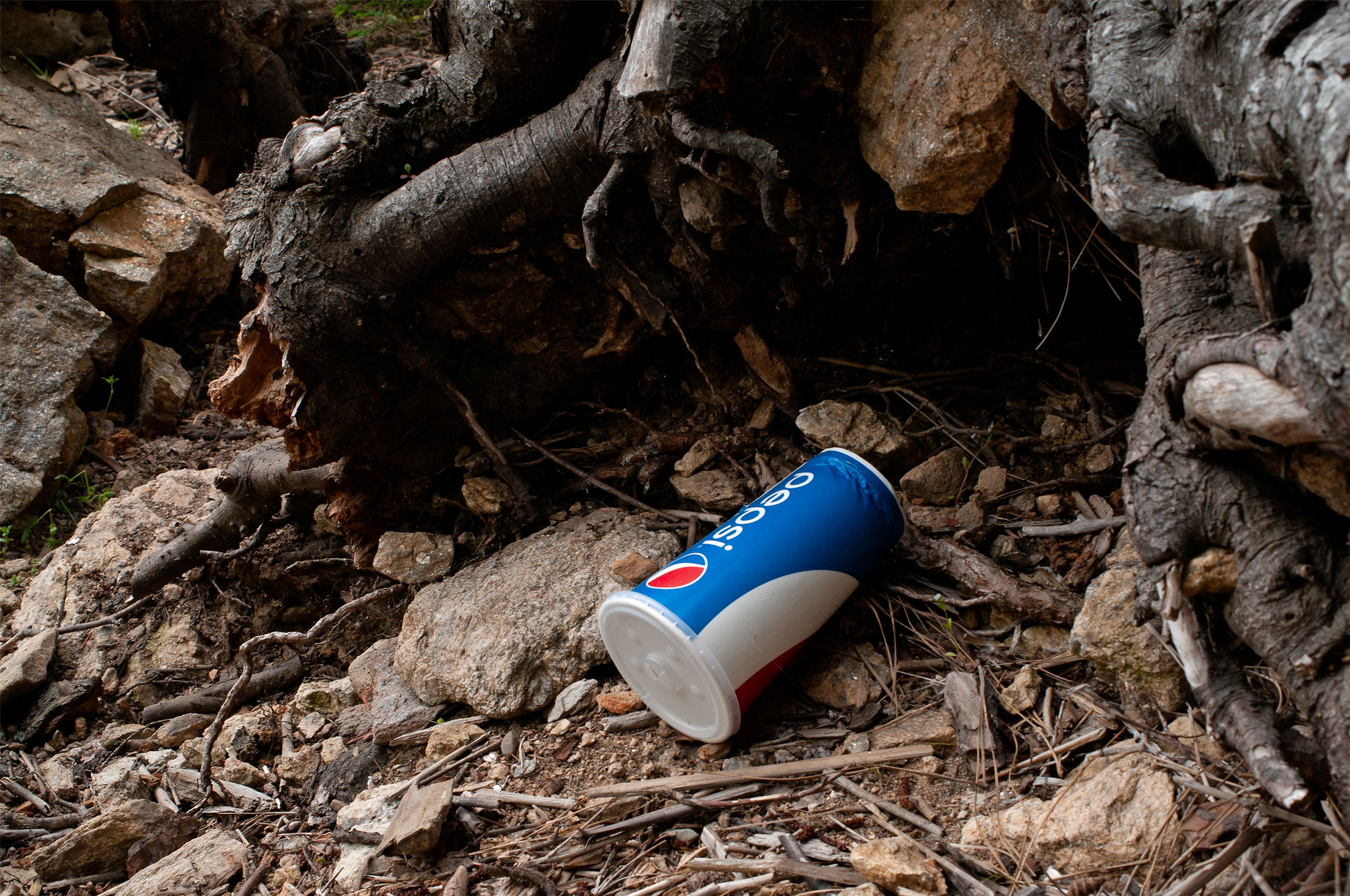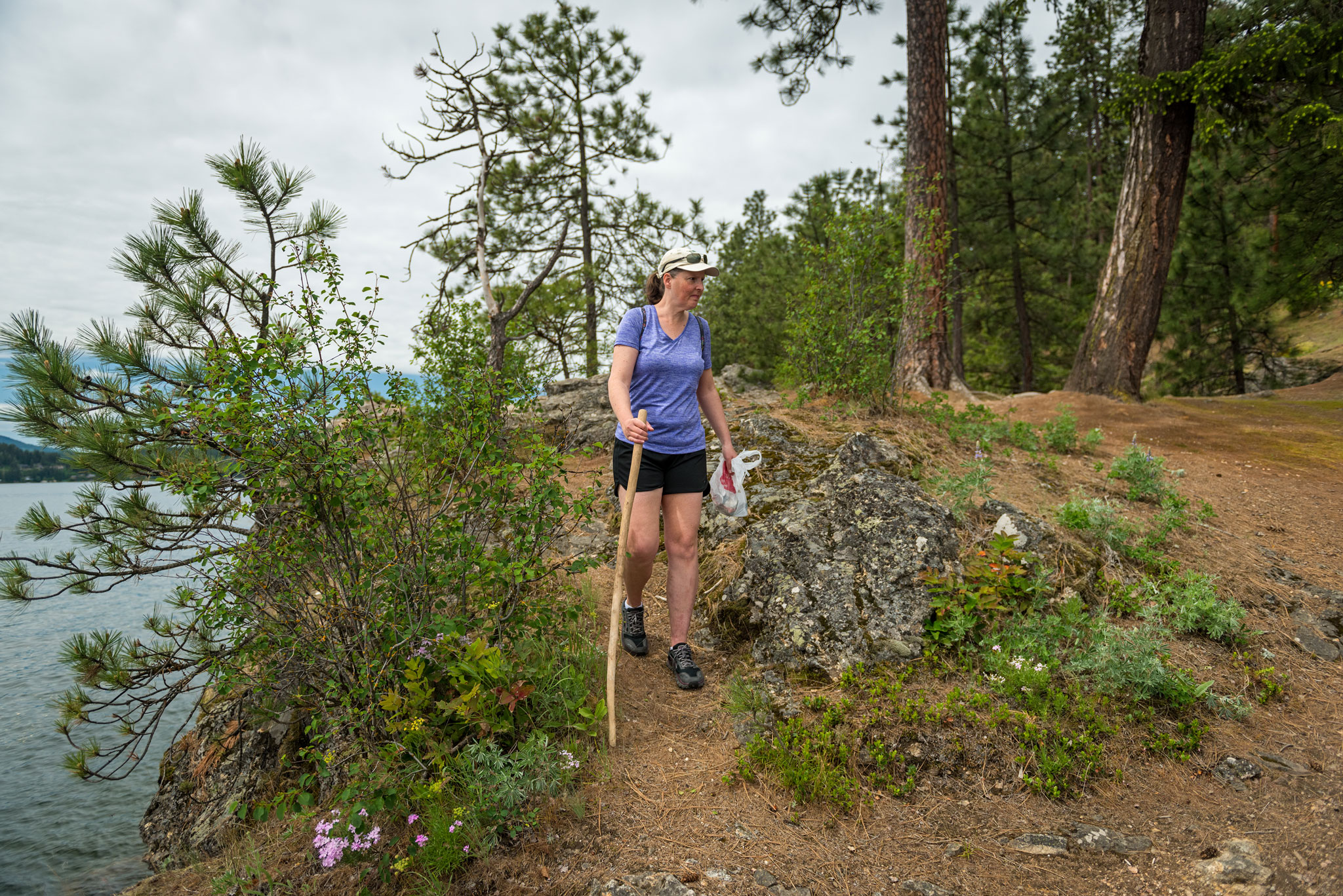We are spoiled here in the Pacific Northwest. We have the convenience of thriving cities and towns with effortless public access to luscious mountains, streams, lakes and trails. Some of these natural spaces even lie in the very center of our cities. And yet, so many of us take them for granted, opting for convenience and ignorance over cleanliness and caretaking. Look around you on your next hike and take in the amount of trash polluting our trails.
» The Popular Trash
A few years ago, my husband and I joined representatives from Spokane Riverkeeper and a handful of volunteers for a day of trail cleanup in Spokane. We grabbed our rolls of trash bags and trekked down a wide section of the Centennial Trail along the Spokane River. The main trail was littered with the typical bits of paper, cigarette butts and drink cans. But off on the side paths, we discovered clothing, furniture, rusted cars, piles of plastic bottles, foam cups and much more. The amount of trash was eye opening.

“In my experience, the easier the access the more amounts of trash,” says Dylan Stiegemeier, founder of The Theodores (www.thetheodores.org), a trash cleanup club started in the Inland Northwest. “Any turnout on the national forest always has lots of cans and bottles at the bottom.”
While plastic and glass bottles, cans, cigarette butts and paper cups seem to be popular trail trash items, you may discover some other pollutants as well. On backcountry trails, toilet paper is frequently left behind. Yes, used toilet paper. “We don’t pick up toilet paper. When we see it, we try to bury it,” says Rob Coughlin, president of Granite Gear, a backpack company in Two Harbors, Minn. In 2017, Coughlin and his company launched a nationwide cleanup program called Grounds Keepers. Their “Keepers” and partners gather trash from trails and report the weight of each collection.
On urban and highly accessible state park trails, pet waste is more of an issue than human waste. For Dave Dutro, avid runner, mountain biker and hiker, as well as founder of Trail Maniacs, poop on the trail is one of his biggest “pet” peeves. “I understand if you’re on the national forest with your dog and you don’t want to pack it all the way back,” says Dutro. “Just get it off the trail, at least.” Most trailheads provide baggies for pet owners to take on the trail with them. Still, some owners leave full bags sitting next to the trail, as if they anticipate a paid worker will come along for the sole purpose of picking them up.

Other pollutants could be anything. Bodycare products like shampoo, soap and toothpaste seep into the ground and contaminate our waterways, plants and animals. Monte McCully, the trails coordinator for the city of Coeur d’Alene, has come across drug paraphernalia, backpacks and clothes on the city’s Centennial Trail and Tubb’s Hill, a protected public recreation area in the heart of downtown.
In 2017, a Grounds Keeper found a 16-pound bowling ball “in the middle of nowhere.”
The guys from Packing It Out pulled a queen-size mattress off the Appalachian Trail in 2015. And Dutro suggests listening to headphones while hiking, walking or running on the trail could also be considered a pollutant. “When you come up on someone, and they’re wearing headphones, they can’t hear you,” he explains. “You can call out to them several times and still scare them.”

» What’s the Problem?
As society and industry progresses, we continue to produce more plastics, glass and other non-sustainable, non-biodegradable trash. “All the plastic has to go somewhere,” says Stiegemeier. “Poor countries with limited resources are being buried in the stuff.”
Problems can also arise when people are unaware. For example, they think something is compostable or biodegradable and it isn’t, at least not in the forest or on the trail. Many plant-based plastic cups labeled “compostable” are actually only “commercially compostable” in their fine print. They have to go through a time-dependent process in a certain environment to break down properly.
And then, of course, there are those who just don’t care.
» Investing In Our Mountains
But for every person who doesn’t care about the trash he or she leaves behind, there’s likely a person who does.
“I think the trail trash pollution situation is better than it was 10 years ago,” says Dutro. “There’s been so much education and an increase in general concern for what we’re leaving for everyone else.”
Story continues after a quick message from our sponsor below.
McCully agrees. “There is definitely a culture of picking up trash when you see it. That has probably kept our natural areas in Coeur d’Alene a lot nicer-looking than they could have been.”
In the 1960s, the U.S. Forest Service established a “No-Trace” program “emphasizing the cultivation of new wilderness ethics and sustainable no-trace travel and camping practices,” according to LNT.org. It was successful in creating awareness, action and knowledge and eventually led to the formation of the Leave No Trace Center for Outdoor Ethics. The tagline, “leave no trace” along with the Seven Principles provided a foundation for other cleanup and action around the country.
The Waterkeeper Alliance publishes a national and international online database of Waterkeepers and Riverkeepers who host regular cleanups and other volunteer efforts. Packing It Out is a small crew dedicated to “Leave It Better.” Founder Seth Orme says, “I realized who was responsible for the decline of our natural and scenic areas. It was ME…it was US.”

Since 2015, Packing It Out has removed close to 2,000 pounds of trash from the Appalachian Trail and the Pacific Crest Trail, combined. This year, the crew is traversing the Snoqualmie Trail in the Northwestern United States. The Grounds Keepers are in various locations around the country and picked up around 10,000 pounds of trash in 2017 with their partners.
Individuals can make a difference, too. Here’s what you can do:
• Carry gloves and a trash bag.
• Be aware and tell others. Stop and chat with your fellow trail user.
• “Pack it in. Pack it out” and “Leave no trace.”
• If you see trash, pick it up.
As environmentalist David Brower says, “If you like nature, you should go to work trying to save some of it.”
Let’s get to work. N
By S. Michael Bennett
Photography By Joel Riner
As Featured In: 2018 Summer/Fall CDA Edition



